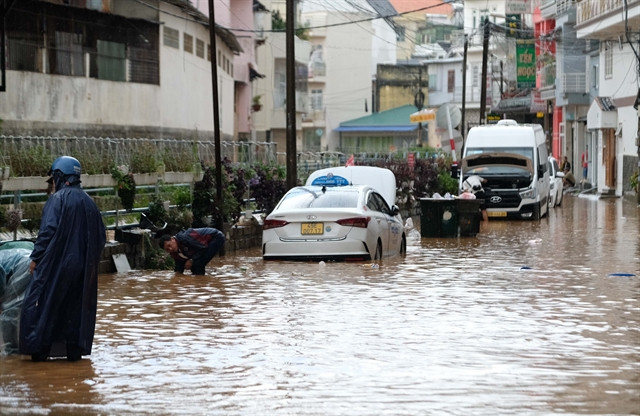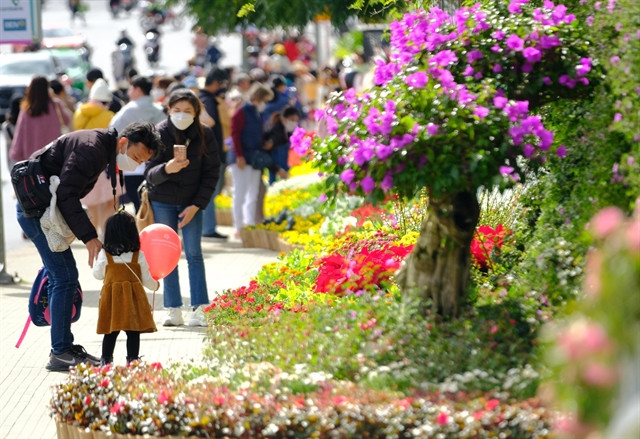 |
| Water submerged Ward 1, Đà Lạt City after heavy rains on July 12. — VNA/VNS Photo Nguyễn Dũng |
Scenes of people having to row boats through the streets in Đà Lạt City, or stories of fatal landslides around the city, are becoming an increasing reality.
Đà Lạt is a city famous for its nature, mild climate, and flowers blooming year-round, but it is now coping with harsh natural disasters.
On July 13, the Đà Lạt People's Procuracy prosecuted two defendants related to a serious landslide in Alley No 36 on Hoàng Hoa Thám Street that killed two people and injured five others. The incident happened on June 29.
Landslides have become more common in Đà Lạt in recent years. Two landslides occurred in the Prenn Pass in two days, June 17 and 18 this year, causing three deaths. Another landslide caused one person to die on Ngô Thì Sỹ Street on March 9 this year.
The city is also suffering from heavy flooding every time it rains heavily. The rain on June 23 and July 12 caused many streets to be submerged in water.
Once a city in a forest, now, with rapid urban development, Đà Lạt City is increasingly losing its green colour due to a series of high buildings.
Đà Lạt now has more than 3,000 hotels of different kinds.
Everyone is looking for a piece of land with a beautiful view, overlooking valleys or pine hills without caring about the broken natural landscape and the environment being affected.
Streams in Đà Lạt were gradually filled in, replaced by concrete roads and rubbish. Losing its forests and streams, Đà Lạt is increasingly suffocating and becoming sensitive to natural disasters.
Đinh Quốc Dân, deputy director of the Việt Nam Institute of Building Science and Technology under the Ministry of Construction, said that heavy rain is often the trigger for landslides in the city.
The area the recent incident happened is residential with a hill in front, a valley next to it, and a large hill behind.
In the highland regions of Việt Nam with rich and diverse natural landscapes and potential for economic development, people race to build high buildings.
To create a construction site, they often use two methods, he said.
The first is cutting mountain slopes into plateaus with a steep slope of 50-70 degrees or more. When it rains, the soil soaks it up, leading to a decrease in durability.
If the plateaus are not properly reinforced and protected, they will collapse.
Management
Discussing solutions to prevent landslides in Đà Lạt, Dân said that it was necessary to review the management and issuance of construction permits in specific locations and maximise work safety.
Associate Professor Lưu Đức Hải, chairman of the Việt Nam Association of Environmental Economics, proposed that investment projects follow the Law on Environmental Protection 2020, and have an approved environmental impact assessment report or environmental commitment.
For infrastructure construction projects in areas with complex geological conditions, technical solutions to prevent environmental incidents must be required, he said.
Local management agencies need to review all projects to see if they have enough of these contents. If they don't, the agencies need to request immediate measures to avoid creating similar problems.
Along with that, said Hải, for tourism infrastructure construction projects, their environmental impact must be appraised by the environmental management agency.
If there is no assessment or the assessment is not seriously carried out, the project owner and the environmental management agency must bear the responsibility for any problems.
Action
 |
| Tourists visit Đà Lạt City, which is famous for its abundance of flowers. — VNA/VNS Photo Nguyễn Dũng |
Speaking at the fifth National Environment Conference last year, Deputy Prime Minister Lê Văn Thành emphasised that the Party and State attached great importance to environmental protection, for the people's lives, health and well-being and for the country’s sustainable development.
"The Party’s and State’s point of view is not to sacrifice the environment in exchange for the economy, not to develop the economy without protecting the environment," he said.
In line with the Party’s, State’s and Government’s direction, the system of environmental protection policies has been increasingly improved in recent years.
The Law on Environmental Protection 2020 has many new regulations.
The draft amended Law on Land 2013 and the draft amended Law on Water Resources 2012 are being widely consulted from all walks of life.
In the National Strategy for Environmental Protection to 2030, with a vision to 2050, Việt Nam's goal is clearly stated that the environment is to be of good quality, ensuring the right to live in a clean and safe environment for the whole of the people.
Biodiversity is preserved and ecological balance is ensured. In a society in harmony with nature, a green economy will be formed and developed, towards the goal of carbon neutrality.
The programme of planting one billion trees in the 2021-25 period was launched by Prime Minister Phạm Minh Chính with the message "For a green Việt Nam".
It is of great significance to greening bare land, and bare hills, restoring ecosystems, and enhancing the green colour in every street corner, schoolyard, and household.
Under the programme, by the end of 2025, the whole country strives to plant one billion trees, of which 690 million trees are scattered in urban areas and 310 million trees in forests.
The target is to protect the ecological environment, improve the landscape and respond to climate change.
The campaign of planting one billion trees is also the basis for Việt Nam to participate in the effective carbon market when the Ministry of Natural Resources and Environment is developing a draft project "Development carbon market in Việt Nam".
Under the project, by 2025, Việt Nam will start piloting and by 2028 will officially operate a carbon credit exchange. — VNS